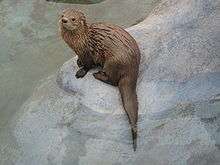Marine otter
The marine otter (Lontra felina) is a rare and relatively unknown South American mammal of the weasel family (Mustelidae). The scientific name means "otter cat", and in Spanish, the marine otter is also often referred to as gato marino: "marine cat". The marine otter (while spending much of its time out of the water) only lives in saltwater, coastal environments and rarely ventures into freshwater or estuarine habitats. This saltwater exclusivity is unlike most other otter species, except for the almost fully aquatic sea otter (Enhydra lutris) of the north Pacific.
| Marine otter | |
|---|---|
 | |
| Scientific classification | |
| Kingdom: | Animalia |
| Phylum: | Chordata |
| Class: | Mammalia |
| Order: | Carnivora |
| Family: | Mustelidae |
| Genus: | Lontra |
| Species: | L. felina |
| Binomial name | |
| Lontra felina (Molina, 1782) | |
 | |
| Marine otter range | |
Description
The marine otter is one of the smallest otters and the smallest marine mammal,[2][3] measuring 87 to 115 cm (34 to 45 in) from the nose to the tip of the tail and weighs 3 to 5 kg (6.6 to 11.0 lb). The tail measures 30 to 36 cm (12 to 14 in).[4][5] Its fur is coarse, with guard hairs measuring up to 2 cm (0.79 in) in length covering dense, insulating underfur. The marine otter is dark brown above and on the sides, and fawn on the throat and underside.[4]
The marine otter has webbed paws and strong claws. The ventral side (underside) of the paws are partially covered in fur. It has 36 teeth and a dental formula of 3.1.3-4.13.1.3.2. The teeth are developed for slicing instead of crushing. The marine otter does not display sexual dimorphism.[4]
Distribution and habitat
Marine otters are found in littoral areas of southwestern South America, close to shore and in the intertidal areas of northern Peru (from the port of Chimbote), along the entire coast of Chile, and the extreme southern reaches of Argentina.[1] Occasional vagrant sightings still occur as far afield as the Falkland Islands.
The marine otter mainly inhabits rocky shorelines with abundant seaweed and kelp, and infrequently visits estuaries and freshwater rivers. It appears to select habitats with surprisingly high exposure to strong swells and winds, unlike many other otters, which prefer calmer waters. Caves and crevices in the rocky shorelines may provide them with the cover they need, and often a holt will have no land access at high tide. Marine otters avoid sandy beaches.
Feeding
Little is known about the diet of marine otters, but their primary prey is believed to be crab, shrimp, mollusks, and fish. They also eat many types of crustaceans.[1]
Behavior and reproduction
Marine otters are most often seen individually or in small groups of up to three. They are difficult to spot, swimming low in the water, exposing only their heads and backs. It is not known whether they are territorial, as males are occasionally seen fighting, yet fights have also been observed even between mating pairs. Fighting takes place on prominent rocks above the waterline, which are also used for resting, feeding, and grooming. Marine otters have also been observed feeding cooperatively on large fish, but it is not known how common the practice is.
The otters are diurnal.
Marine otters may be monogamous or polygamous, and breeding occurs in December or January. Litters of two to five pups are born in January, February or March after a gestation period of 60 to 70 days. The pups remain with their mother for about 10 months of parental care, and can sometimes be seen on the mother's belly as she swims on her back, a practice similar to that of the sea otter. Parents bring food to the pups and teach them to hunt.
Conservation status
Marine otters are rare and are protected under Peruvian, Chilean, and Argentine law.[1] In the past, they were extensively hunted both for their fur and due to perceived competition with fisheries. Hunting extirpated them from most of Argentina and the Falkland Islands. Poaching is still a problem, but one of unknown magnitude. It is unknown how many marine otters exist in the wild or what habitats should be preserved to encourage their recovery. Marine otters were listed under CITES Appendix I in 1976, and are listed as endangered by the U.S. Department of the Interior.
References
- Valqui, J.; Rheingantz, M.L. (2015). "Lontra felina (errata version published in 2017)". IUCN Red List of Threatened Species. 2015: e.T12303A117058682. Retrieved 14 February 2020.
- "The Hunt: Race Against Time (Coasts)". BBC. Retrieved 6 December 2015.
- "Chilean marine otter: Meet the sea cat". BBC Wildlife. Immediate Media Company. 30 March 2011. Retrieved 31 May 2018.
- Jefferson, Thomas A.; Webber, Marc A.; Pitman, Robert L. (2015). Marine Mammals of the World: A Comprehensive Guide to their Identification. San Diego: Academic Press. pp. 539–541. ISBN 978-0124095922.
- "Marine Otter - Lontra felina". Encyclopedia of Life. n.d. Retrieved 31 May 2018.
External links


